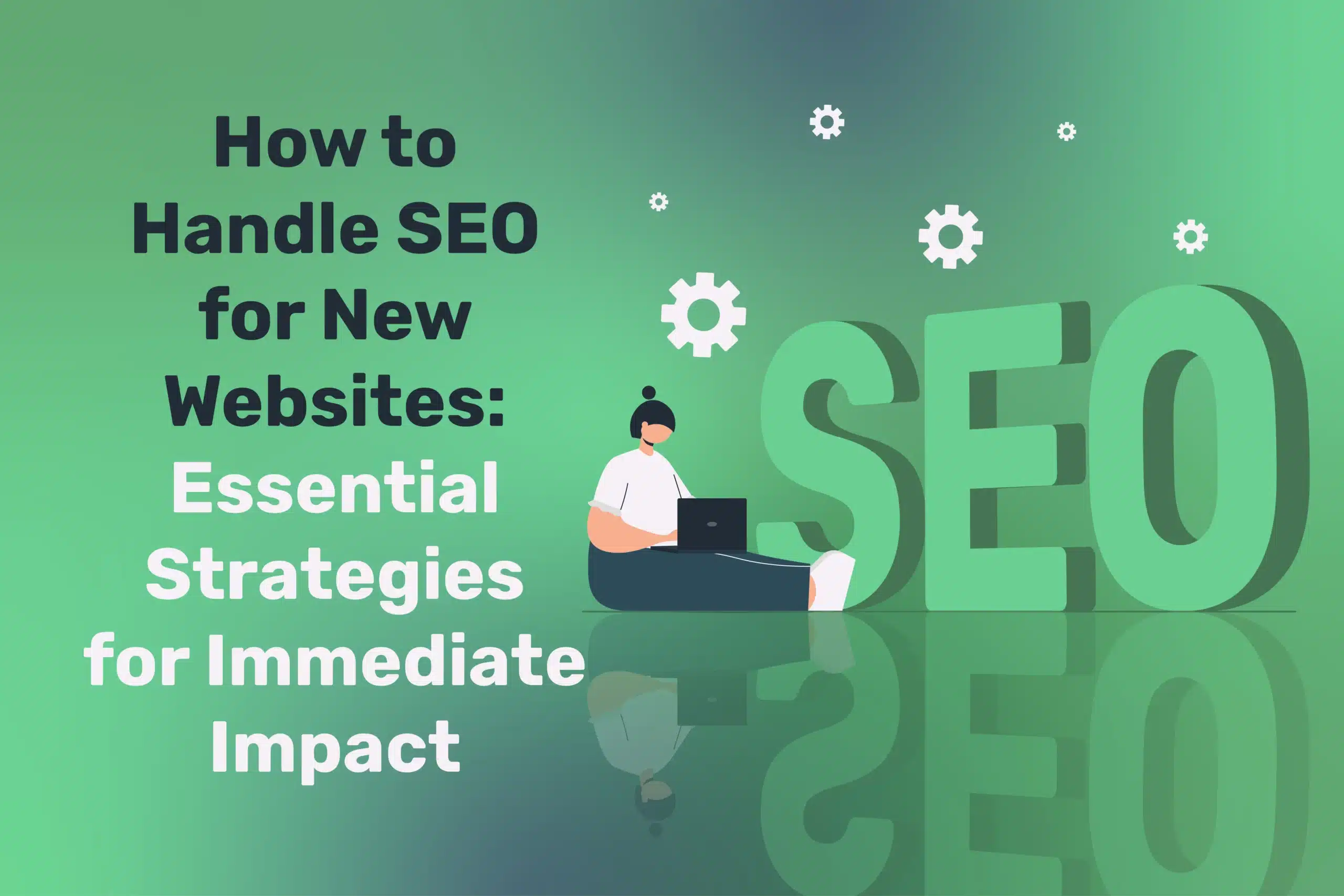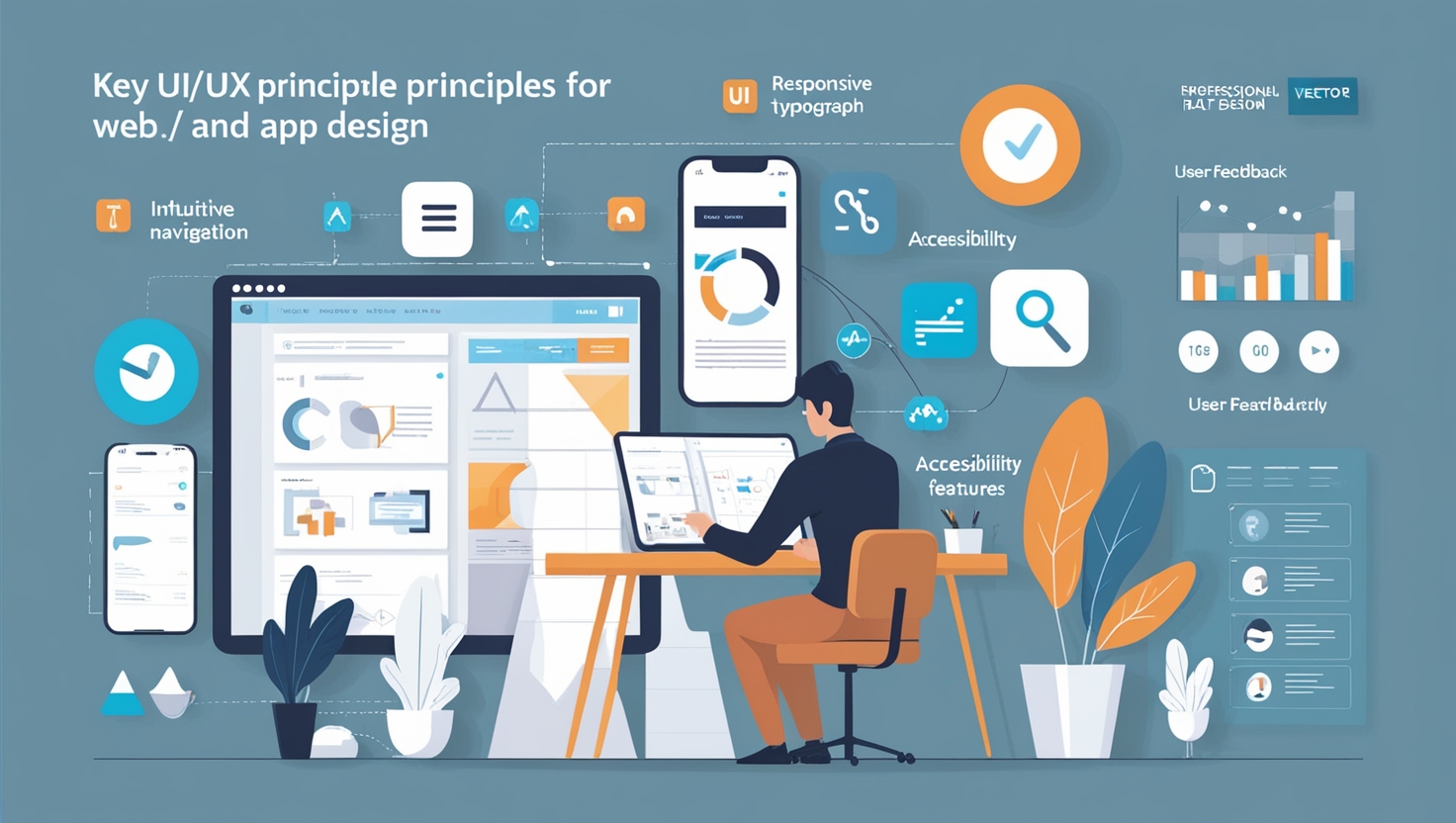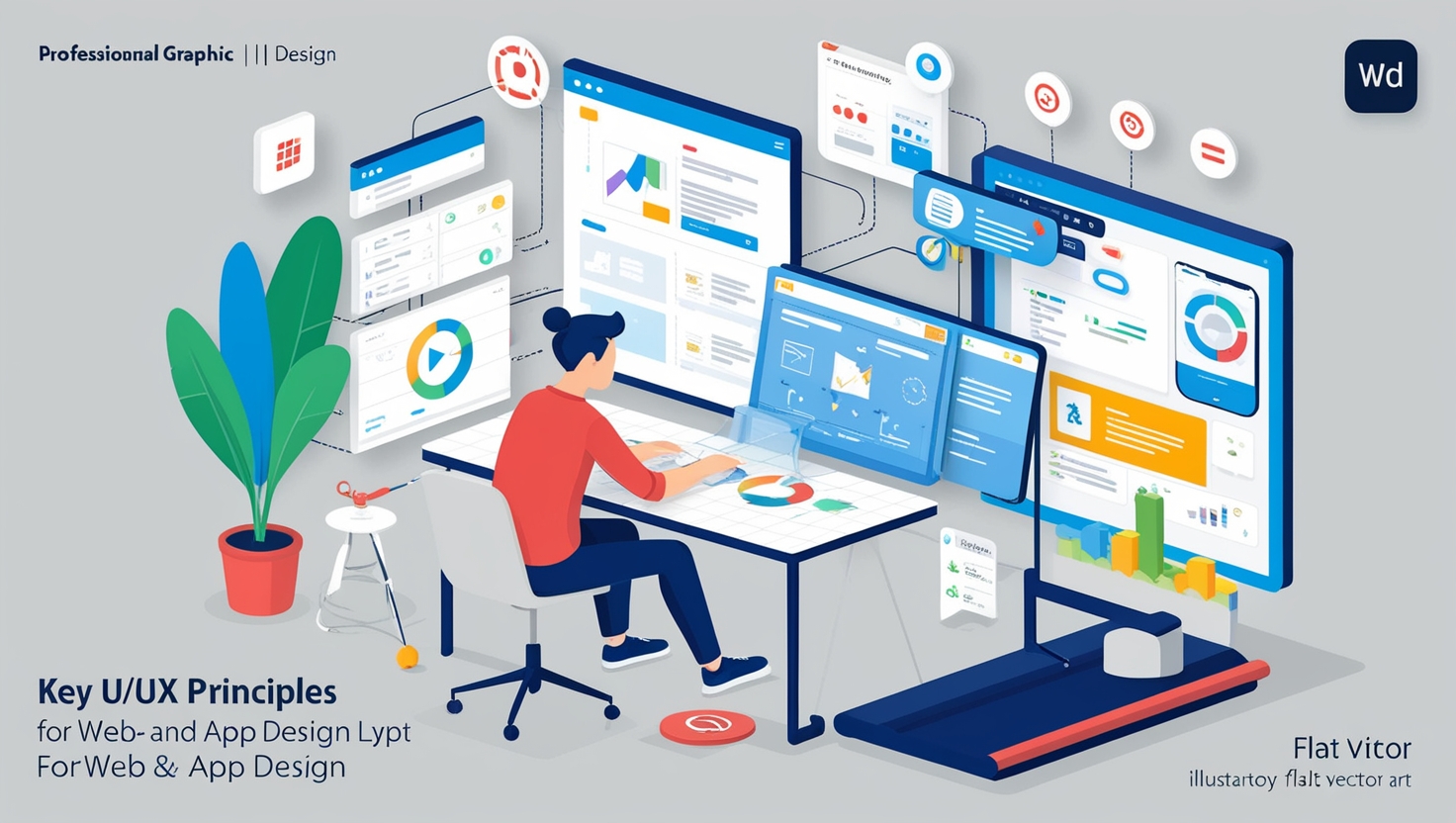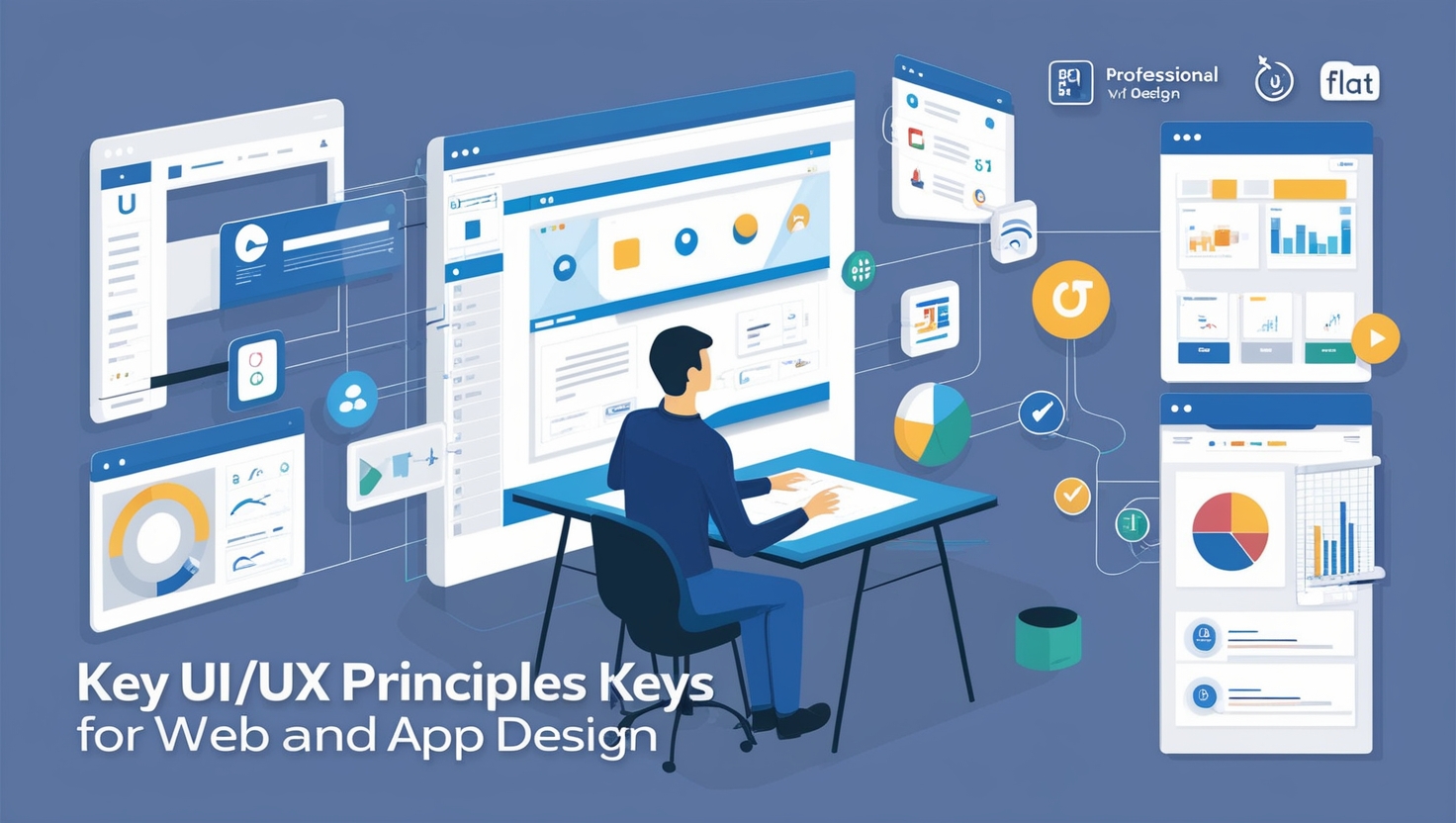
Designing for Conversion: 7 UI/UX Principles to Boost Lead Generation
Table of Contents
A visually appealing website alone won’t guarantee new customers or sign-ups. Effective UI/UX design must guide visitors seamlessly toward key goals—like filling out a contact form, adding items to a cart, or subscribing to a newsletter. In 2025, users face countless online distractions, and friction or confusion quickly leads them to abandon.
This article reveals seven crucial UI/UX principles that enhance your site’s ability to convert visitors. From intuitive navigation and persuasive calls-to-action (CTAs), to trust-building design cues, these best practices forge user journeys that end in meaningful actions—sustaining your brand’s lead generation and revenue growth.
“Designing for conversion is about aligning visuals and flows with human psychology. Ease, clarity, and trust define which sites users engage with or exit from,” says Ciaran Connolly, Director of ProfileTree.
Clarity and Simplicity
A clear and simple UI/UX design ensures users can navigate a website or app effortlessly. By minimising clutter, using intuitive layouts, and prioritising essential elements, you create a seamless experience that reduces frustration. Every design choice should enhance usability, guiding users toward their goals without unnecessary complexity.
Minimal Distractions
Each page should have a single dominant objective—like “Request a Quote” or “Add to Cart”—that stands out clearly. Keep unrelated content, excessive visuals, or competing CTAs away from the primary path to maintain focus. Use whitespace, contrast, and strategic placement to guide users naturally toward the next step. Overly cluttered pages create friction and cognitive overload, making visitors less likely to complete the intended action. A streamlined, distraction-free design improves clarity and boosts conversion rates.
Straightforward Navigation
Ensure your menu labelling is clear and intuitive (e.g., “Services,” “Pricing,” “Contact”) rather than vague or overly creative. Group related subpages logically to help users navigate effortlessly. A concise top-level menu prevents decision fatigue and improves accessibility. Aim to minimise the number of clicks required to reach essential pages—like a booking form or checkout—to streamline the user journey and boost conversions.
Chunking Information
If you present complex data—such as product features, pricing tiers, or comparisons—break it into digestible formats like short paragraphs, bullet points, or collapsible sections. Using tables, icons, or subtle colour coding can further enhance clarity and visual appeal. This “chunking” approach makes information scannable, helping users quickly find what matters without getting lost in dense text. Additionally, consider progressive disclosure—showing basic details first with an option to reveal more—so users can engage at their own pace.
Persuasive Calls-to-Action
Effective calls-to-action (CTAs) guide users toward desired actions, whether it’s making a purchase, signing up, or exploring content. A persuasive CTA combines clear wording, strategic placement, and compelling design to drive engagement. Strong verbs, urgency, and value-driven messaging make CTAs more impactful, encouraging users to take the next step.
Strategic CTA Placement
A well-designed CTA stands out on the page, using contrasting colours, clear text, and ample spacing. If your conversion goal is sign-ups, position CTA buttons in high-visibility spots—above the fold, at the end of content sections, or after key selling points. Reinforce urgency with action-driven wording like “Get Started Now” or “Claim Your Offer.” Minimising scrolling or searching ensures users can take action quickly, reducing friction and boosting conversions.
Action-Oriented Language
Use commanding but relevant text that directly conveys value, such as “Get Your Free Quote,” “Start My Trial,” or “Book My Consultation.” Avoid vague CTAs like “Submit” or “Learn More,” as they lack motivation. Instead, tie the action to a clear benefit—like “Access My 10% Discount Now” or “Unlock Exclusive Content.” The more specific and enticing your CTA, the higher the likelihood of conversion.
Contrasting Colours
Pick a CTA button hue that contrasts strongly with the background or general colour scheme. A bright accent colour often works. This visual emphasis helps the button pop, guiding user focus. Ensure your brand guidelines remain consistent, but CTA can deviate to stand out.
Microcopy Reinforcing Value
A brief reassurance near the CTA can ease doubts and encourage action. Phrases like “No credit card required,” “Takes less than 2 minutes,” or “We’ll respond within 24 hours” help remove friction and set clear expectations. Additionally, addressing potential concerns—such as security (“100% encrypted and secure”) or commitment levels (“Cancel anytime”)—can further boost user confidence and increase conversions.
“A CTA is a gateway. Design and copy must instantly convey the reward for clicking,” adds Ciaran Connolly.
Consistency and Visual Hierarchy

Consistency and visual hierarchy are fundamental to a seamless user experience. Maintaining uniform typography, colours, and spacing across a site builds familiarity and trust. A clear hierarchy, achieved through contrast, size, and positioning, directs users’ attention to key elements, ensuring intuitive navigation and improved engagement.
Consistent Styling
Maintain uniformity in fonts, button shapes, colour palette, and spacing across the site to create a cohesive experience. If each page or section drastically differs, visitors may feel disoriented, making navigation less intuitive. Consistency fosters brand recall and user comfort, elevating trust while reinforcing professionalism. A well-structured, predictable design also reduces cognitive load, allowing users to focus on the content and actions rather than figuring out how to navigate the site.
Hierarchical Layout
Use size, weight, and placement to signal importance, ensuring key elements stand out at a glance. The page headline, subheadline, and CTA should be the most prominent, followed by supporting text or images that reinforce the message. Strategic use of whitespace and contrast further directs attention, preventing clutter. A clear visual hierarchy helps visitors skim effortlessly, guiding them toward the desired action with minimal friction.
Logical Content Flow
Lead with a compelling headline that instantly communicates the core benefit to grab attention. Follow up with supporting facts, visuals, or testimonials that reinforce credibility and address potential objections. Use concise, scannable text and engaging imagery to maintain interest without overwhelming users. Organise content in a logical flow, ensuring each section builds on the previous one, leading users smoothly toward a decision.
Conclude with a strong, visually distinct CTA, making the next step clear and easy to take. This structured storytelling approach keeps users engaged, reassures them of their choice, and ultimately drives higher conversions.
Trust-Building Elements
Trust-building elements are essential for fostering credibility and user confidence. Features like clear contact information, SSL certificates, customer testimonials, and recognisable security badges reassure visitors. A professional design, transparent policies, and consistent branding further reinforce reliability, making users more likely to engage and convert.
Testimonials and Social Proof
Real user reviews, star ratings, or client logos assure potential customers of your credibility. Position these near relevant CTAs: e.g., a testimonial about quick delivery next to the “Buy Now” button for an online retailer. Authentic, detailed quotes outperform generic praise.
Security Seals and Certifications
Additionally, showcase customer reviews, star ratings, or case studies near key decision points to reinforce trust. If offering money-back guarantees or free returns, highlight these policies prominently to ease hesitation. Trust signals like secure payment icons, verified testimonials, and clear refund policies reassure visitors, increasing their confidence in completing a purchase or booking.
Clear Privacy Policy and Terms
Link your privacy policy and terms in the footer or near sign-up forms, ensuring they are easy to find. Summarise key points in plain language, such as “We never sell your data” or “You can unsubscribe anytime,” to reassure users. Consider adding a brief tooltip or pop-up explanation near checkboxes for data consent, clarifying how their information will be used.
If applicable, highlight compliance with regulations like GDPR or CCPA, reinforcing transparency. Providing this clarity builds trust, encourages conversions, and helps users feel in control of their personal information.
Professional Design Polish
Outdated or sloppy designs undermine credibility. Crisp images, well-formatted text, and consistent margins signal professionalism. If your site looks neglected, visitors might assume your services are too.
Fewer Steps, Faster Conversions

Minimising friction in the user journey leads to higher conversion rates. Streamline forms, reduce unnecessary fields, and enable autofill where possible. Offering guest checkout, one-click purchasing, or social logins can speed up the process. Every extra step risks drop-offs, so keep the path to conversion as direct as possible.
Short Forms
Long forms deter sign-ups. Ask only essential details. If you need more info later, proceed in subsequent steps or post-sign-up. Breaking forms into multiple steps (like personal info, then shipping, then payment) can feel more manageable—just ensure you keep each step minimal.
Guest Checkout Options
For e-commerce, don’t force account creation upfront, as it can create friction and lead to cart abandonment. A streamlined guest checkout option often improves conversion rates by allowing users to complete their purchase quickly. At the end of the process, offer optional account creation with clear benefits, such as faster repeat purchases, order tracking, or exclusive discounts.
Keeping the process flexible ensures a smoother user experience while still encouraging long-term customer retention.
One-Click or Social Login
For sign-up or checkout, letting users log in with Google, Apple, or Facebook can speed the process. The fewer fields or password setups, the less friction. Provide a standard email option for those who dislike social logins.
Progress Indicators
For multi-step forms, transparency is key. Display a clear progress bar, step count (e.g., “Step 2 of 4”), or percentage completed to manage expectations. This reassures users they’re making progress and reduces abandonment rates. Where possible, allow navigation between steps so users can review or edit previous entries without losing data. Additionally, keep each step focused—only ask for essential details per section to prevent cognitive overload. If feasible, provide a “Save & Continue Later” option for longer processes, giving users flexibility while maintaining engagement.
“The more hoops you make users jump through, the fewer will complete. Stripping friction is key to higher conversion,” says Ciaran Connolly.
Mobile-Optimised UX for Conversions
A mobile-friendly experience is essential for driving conversions. Ensure responsive design, fast-loading pages, and touch-friendly buttons. Simplify navigation with clear menus and minimise form fields for easier input. Mobile users expect seamless interactions—slow load times or frustrating layouts can lead to high bounce rates. Prioritise a frictionless, engaging experience to boost conversions.
Thumb-Friendly Buttons
Design with one-handed usage in mind by placing key CTA buttons within easy thumb reach, typically near the bottom of the screen. Ensure buttons are large enough for effortless tapping, and avoid tiny, closely spaced links that can lead to accidental clicks. Maintain adequate whitespace around interactive elements to enhance usability, reducing frustration and making navigation seamless on mobile devices. Prioritising touch-friendly design improves accessibility and encourages smoother user interactions.
Simplified Navigation
For mobile navigation, keep it intuitive and clutter-free. Hide deeper menu levels within a hamburger menu or collapsible sections, prioritising top-level categories for quick access. Overcomplicated menus can frustrate users, leading to drop-offs.
Additionally, keep key CTAs—such as “Call Now,” “Get a Quote,” or “Shop Now”—fixed or easily reachable without excessive scrolling. If search is a primary function, ensure the search bar is visible or quickly expandable. A frictionless mobile experience encourages engagement and conversion while keeping navigation smooth and efficient.
Auto-Fill and Validation
Use HTML input attributes like type="email" and type="tel", along with autocomplete hints, to streamline form entry on mobile devices. This allows browsers to suggest relevant inputs, reducing manual typing. If users enter invalid data, display clear, inline error messages with specific guidance (e.g., “Please enter a valid email address” rather than a generic “Invalid input”). Minimising re-typing and ensuring a seamless error-correction process enhances user experience, reducing frustration and abandonment rates.
Avoid Interstitial Intrusions
Large pop-ups or ads that obscure content hamper mobile experiences. Google also penalises intrusive interstitials that block the main content. If using a welcome overlay or email capture, keep it small, easily dismissible, and appear after a slight delay—once visitors see some content.
Iterative Testing and Continuous Refinement

A great UX/UI design isn’t static—it evolves based on user behaviour and performance insights. Regular A/B testing, heatmaps, and session recordings help identify pain points and opportunities for improvement. Continuously refine layouts, interactions, and messaging to optimise for conversions. Small, data-driven adjustments over time lead to a more effective and user-friendly experience.
A/B Testing CTAs and Layouts
A/B testing allows you to pinpoint subtle yet impactful changes that influence user behaviour. Try testing different CTA button colors—perhaps a bold contrast like orange vs. blue—or tweak the headline to emphasise urgency (“Limited Offer: Sign Up Today” vs. “Join Now for Exclusive Benefits”). You can also experiment with testimonial placement, moving them closer to the CTA or highlighting a key customer quote in a larger font. Monitor conversion metrics like click-through rates, form submissions, or purchases to determine the most effective version. Regular iteration based on test results ensures your landing page continuously evolves for maximum impact.
Heatmaps and Session Recordings
Session recordings and heatmaps from tools like Hotjar or Microsoft Clarity help identify usability issues by tracking where users click, scroll, or drop off. A heatmap might reveal that a key CTA is being ignored, or that users struggle to navigate a multi-level menu.
Similarly, session recordings can expose friction points, such as repeated form submissions due to unclear validation errors. By analysing real behaviour patterns rather than relying on assumptions, you can make data-driven design adjustments that enhance user experience and improve conversions.
Microcopy and Form Field Tweaks
A/B testing subtle copy variations can reveal surprising insights into user behaviour. For instance, emphasising immediacy (“Get Instant Access”) versus reassurance (“Risk-Free Trial”) may appeal to different audiences. Even tweaking button text—“Claim Your Discount” instead of “Apply Coupon”—can shift conversions. Beyond wording, experiment with form simplification: reducing required fields or adjusting labels for clarity. If a multi-step form sees high drop-off, test a single-page version.
Continuous small refinements based on real user responses can significantly improve engagement and conversion rates over time.
Performance Observations
Slow-loading pages can frustrate users and harm conversions. If performance lags, revisit optimisations like lazy loading images, compressing assets further, or deferring non-essential scripts. Tools like Google PageSpeed Insights or Lighthouse can pinpoint bottlenecks—whether it’s a heavy font file, unoptimised third-party script, or excessive DOM elements.
Regularly monitor key metrics such as Largest Contentful Paint (LCP), First Input Delay (FID), and Cumulative Layout Shift (CLS) to ensure a seamless experience. Even small speed gains can enhance perceived responsiveness, keeping users engaged and reducing bounce rates.
“Optimising conversions is an ongoing process. Gather data, refine layouts, retest—repeat. Incremental gains add up significantly,” highlights Ciaran Connolly.
Converting Visitors into Customers Through Thoughtful UI/UX Principles
Every design decision—from how you group content to the size, colour, and copy of your CTA—impacts whether visitors stay or bounce. By adopting these UI/UX principles, you streamline user journeys, deliver a consistent brand experience, and reduce friction at each conversion point. A site built with clarity, trust elements, and minimal steps fosters meaningful engagement, ultimately driving revenue or lead growth.
In the fast-paced digital era of 2025, competition is fierce, and user patience is thin. Prioritising a conversion-focused design ensures your site stands out—helping visitors find and act on your value proposition swiftly. Keep testing, refining, and aligning your web design with user psychology, and watch your conversions climb steadily over time.




